Book Series
Easy – Plain – Accessible
This book series is edited by Silvia Hansen-Schirra and Christiane Maaß. It is affiliated to this platform and dedicated to innovative research on easy, plain and accessible communication. If you are interested in submitting a book proposal please contact the editors: info@easy-plain-accessible.com
Access the full series published with Frank & Timme here.
Below is a list of all volumes published in this series so far.
Click on the individual titles for more information.
Vol. 1 (2020)
Isabel Rink: Rechtskommunikation und Barrierefreiheit
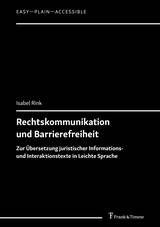
Rechtskommunikation und Barrierefreiheit:
Zur Übersetzung juristischer Informations- und Interaktionstexte in Leichte Sprache
Author: Isabel Rink
Content (German)
Barrierefreie Rechtskommunikation scheint ein Widerspruch in sich zu sein: Die juristische Fachsprache stellt hohe Anforderungen an das Verstehen. Leichte Sprache hingegen zielt auf maximale Verständlichkeit. Isabel Rink lotet die Möglichkeiten für erfolgreiche barrierefreie Rechtskommunikation aus. Sie zeigt, wie es gelingen kann, die einschlägigen Textsorten für alle zugänglich zu machen. Dabei nimmt sie ein Pilotprojekt des Niedersächsischen Justizministeriums in den Blick: „Leichte Sprache in der Niedersächsischen Justiz“. Sie zeigt, wie Texte der juristisch-administrativen Kommunikation gestaltet sein müssen, um für Menschen mit Wahrnehmungs- und Verstehenseinschränkungen wahrnehmbar, verständlich, akzeptabel und handlungsleitend zu sein, sodass auch Adressaten Zugang zum Rechtssystem erhalten, die bisher davon ausgeschlossen waren.
Vol. 2 (2020)
Silvia Hansen-Schirra & Christiane Maaß (eds.): Easy Language Research: Text and User Perspectives
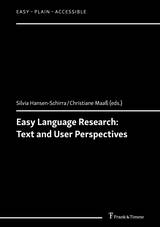
Easy Language Research: Text and User Perspectives
Editors: Silvia Hansen-Schirra & Christiane Maaß
Content
This volume presents new approaches in Easy Language research from three different perspectives: text perspective, user perspective and translation perspective. It explores the field of comprehensibility-enhanced varieties at different levels (Easy Language, Plain Language, Easy Language Plus). While all are possible solutions to foster communicative inclusion of people with disabilities, they have varying impacts with regard to their comprehensibility and acceptability. The papers in this volume provide insights into the current scientific activities and results of two research teams at the Universities of Hildesheim and Mainz and present innovative theoretical and empirical perspectives on Easy Language research. The approaches comprise studies on the cognitive processing of Easy Language, on Easy Language in multimodal and multicodal texts and different situational settings as well as translatological considerations on Easy Language translation and interpreting.
Vol. 3 (2020)
Christiane Maaß: Easy Language – Plain Language – Easy Language Plus
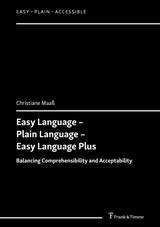
Easy Language – Plain Language – Easy Language Plus
Author: Christiane Maaß
Content
This book shows how accessible communication, and especially easy-to-understand languages, should be designed in order to become instruments of inclusion. It examines two well-established easy-to-understand varieties: Easy Language and Plain Language, and shows that they have complementary profiles with respect to four central qualities: comprehensibility, perceptibility, acceptability and stigmatisation potential. The book introduces Easy and Plain Language and provides an outline of their linguistic, sociological and legal profiles: What is the current legal framework of Easy and Plain Language? What do the texts look like? Who are the users? Which other groups are involved in the production and use of Easy and Plain Language offers? Which qualities are a hazard to acceptability and, thus, enhance their stigmatisation potential? The book also proposes another easy-to-understand variety: Easy Language Plus. This variety balances the four qualities and is modelled in the present book.
Vol. 4 (2020)
Elisa Perego: Accessible Communication: A Cross-country Journey
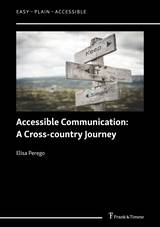
Accessible Communication: A Cross-country Journey
Author: Elisa Perego
Content (German)
Easy-to-Understand (E2U) text practices enable and facilitate accessible communication. E2U refers both to Plain and to Easy Language. These two powerful methods of language and content comprehension enhancement are illustrated through several examples in English, starting from the seminal role of the Anglophone world in promoting plain and lucid style. Originally implemented in written texts, today the employment of these simplified language varieties should infiltrate new communication services that are more complex and multifaceted. Thanks to the EASIT project, the integration of E2U strategies into a selection of audiovisual services is being successfully researched. After advancing simplification proposals in the area of subtitling and audio description, Elisa Perego reports on the results of a cross-country survey conducted during the initial stages of the EASIT project: She pinpoints the background, activity, and training experience of those who currently work in the sector of E2U in Europe, and identifies the skills and the competences of, as well as a training path and materials for, future hybrid professionals.
Vol. 5 (2020)
Silke Gutermuth: Leichte Sprache für alle?
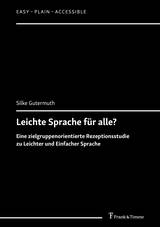
Leichte Sprache für alle?
Author: Silke Gutermuth
Content (German)
Was macht Leichte Sprache leicht? Wie erfolgreich sind neue Sprachvarietäten wie Leichte Sprache und Einfache Sprache? Und wer kann von ihnen profitieren? Mit ihrer zielgruppenorientierten Rezeptionsstudie ermöglicht Silke Gutermuth erstmals die empirische Validierung aktueller Methoden der Verständlichkeitsoptimierung von Texten. Mit einem multimethodischen Ansatz untersucht sie die Rezeption authentischer Texte unterschiedlicher Komplexität durch Menschen mit kognitiven Einschränkungen, Menschen mit Migrationshintergrund und Senioren. Neben einer Analyse des Blick- und Leseverhaltens der Probanden mittels Eyetracking stellt sie die Ergebnisse anschließender Verständlichkeits- und Recall-Tests vor. Die Triangulation dieser Prozessdaten erlaubt die Korrelation textueller Enkodierungsstrategien mit den damit verbundenen kognitiven Dekodierungsprozessen für Leichte und Einfache Sprache. Daraus können erstmalig Schlussfolgerungen über die Effizienz der Textvarianten im Hinblick auf ihre Lesbarkeit und Verständlichkeit gezogen
Vol. 6 (2020)
Anne-Kathrin Gros, Silke Gutermuth & Katharina Oster (eds.): Leichte Sprache – Empirische und multimodale Perspektiven
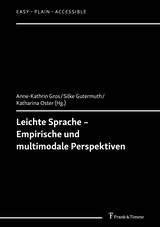
Leichte Sprache – Empirische und multimodale Perspektiven
Editors: Anne-Kathrin Gros, Silke Gutermuth & Katharina Oster
Content (German)
Leichte Sprache ist in der Praxis entstanden und entbehrte lange Zeit einer wissenschaftlichen Fundierung. In den vergangenen Jahren hat die Zahl der Projekte, die Leichte Sprache in den Fokus ihrer Forschung rücken, jedoch rasant zugenommen. Neben Studien von etablierten Forschungsgruppen gibt es auch immer mehr Nachwuchswissenschaftler und -wissenschaftlerinnen, die innovative empirische Untersuchungen durchführen. Der vorliegende Band stellt eine Plattform für diese Arbeiten dar, die als Pilotstudien zumeist nicht veröffentlicht werden. Dazu präsentiert er acht gekürzte und aufbereitete Abschlussarbeiten von Studierenden des FTSK der Universität Mainz in Germersheim und der Universität Hildesheim. Bei den Beiträgen handelt es sich um Rezeptionsstudien sowie um Projekte, die die multimodale Verwendung von Leichter Sprache untersuchen.
Vol. 7 (2020)
Maher Tyfour: Sprachmacht auf engstem Raum: Die Inszenierung der Stadt in den Hörfilmen der Münchner Tatort-Filmserie
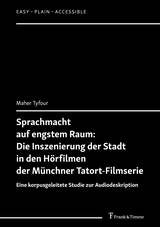
Sprachmacht auf engstem Raum: Die Inszenierung der Stadt in den Hörfilmen der Münchner Tatort-Filmserie
Author: Maher Tyfour
Content (German)
Hörfilme ermöglichen blinden und sehbehinderten Menschen den Genuss eines Spielfilms. Ein Hörfilm besteht dabei aus der Originalaudiospur des Films und aus der Audiodeskription. Diese Filmbeschreibung kompensiert die Videospur des Films. Es handelt sich also um einen rein auditiven Medientext. Die Translationswissenschaft betrachtet die Arbeit der Audiodeskriptoren als intercodalen Übersetzungsprozess und als Teil der audiovisuellen Übersetzung.
Die konkrete Umsetzung von Audiodeskription hat Maher Tyfour an einem Korpus von Bildübersetzungen zur Münchner Tatort-Reihe untersucht. Sein Fokus lag dabei auf den Inszenierungen der Stadt. Im Vergleich mit den Originalvideospuren der Spielfilme verdeutlicht er die intertextuelle Beziehung zwischen Original und Übersetzung. In der Analyse identifiziert er die im Übersetzungsprozess teils unbewusst umgesetzten Strategien der Audiodeskriptoren, erklärt diese und diskutiert sie text- und übersetzungswissenschaftlich.
Vol. 8 (2021)
Camilla Lindholm and Ulla Vanhatalo (eds.): Handbook of Easy Languages in Europe
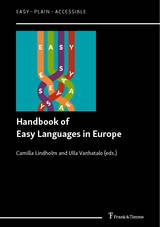
Handbook of Easy Languages in Europe
Editors: Camilla Lindholm and Ulla Vanhatalo
Content
The Handbook of Easy Languages in Europe presents the history and the current status of Easy Languages in Europe. It describes what Easy Language is and how it is used in European countries.
The notion of Easy Language refers to modified forms of standard languages that aim to facilitate reading and language comprehension, resulting in, for example, Easy Slovenian, Easy Spanish, Easy French, or Easy Italian. Easy Languages have been adapted in terms of content, vocabulary, and structure to make them more readable and comprehensible. They are intended for people who have difficulties understanding standard language. Although the term Easy Language usually refers to various kinds of texts, spoken interactions can also be based on the principles of Easy Language.
Modern societies are completely based on linguistic constructions. All people, despite their limitations, have an equal right to information, inclusion, and social participation. This results in requirements for understandable language. Easy Language removes obstacles in the same way as a wheelchair ramp built next to stairs makes a building accessible.
This handbook describes the principles and practices of Easy Language in 21 European countries in 2020 and before. Each chapter follows essentially the same structure. The chapters take their point of departure from the history of Easy Language and accessible communication in a particular country. The historical background is followed by an overview of the current situation, dealing with topics such as terminological definitions, legal status, and stakeholders. Target groups, guidelines, and practical outcomes are discussed under their own subheadings. Education and research are presented together, and each chapter includes a final part in which the authors reflect on future perspectives related to Easy Language in their own countries. This handbook demonstrates the great diversity of actors, instruments and outcomes related to Easy Language throughout the European countries.
This Handbook of Easy Languages in Europe is the first attempt to study the position of easy and accessible language in Europe. Written in an academic yet interesting and understandable style, it aims to find a wide audience all over Europe.
Vol. 9 (2021)
Silvia Hansen-Schirra, Katja Abels, Sarah Signer & Christiane Maaß (eds.): The Dictionary of Accessible Communication
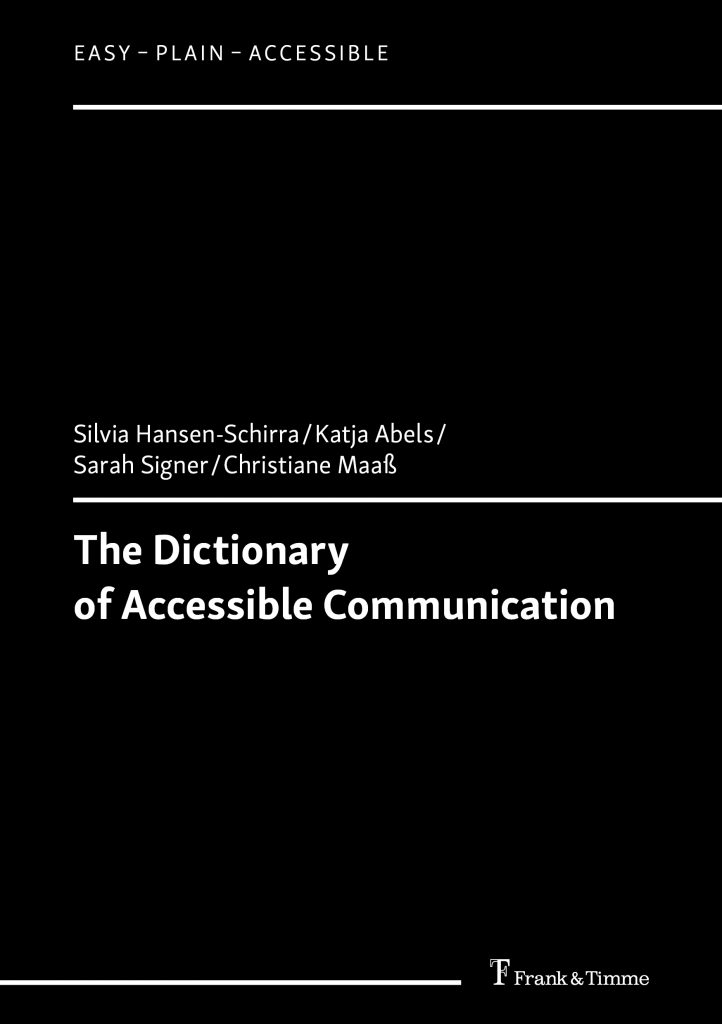
The Dictionary of Accessible Communication
Editors: Silvia Hansen-Schirra, Katja Abels, Sarah Signer & Christiane Maaß
Content
Terminology on Accessible Communication has primarily evolved and been published within the borders of a given country with no or only little exchange across these borders. Since English can be regarded as the lingua franca of science, this first German–English Dictionary of Accessible Communication will help to promote international exchange and an international discourse on this topic by attempting to define concepts that go beyond the scope of a single-country centered approach. The terminological work for this dictionary is based on the German Handbook of Accessible Communication. Most of the handbook’s contents are language-independent and applicable to other recipient communities. On the basis of the German terminology, the English equivalents, definitions and explanations were researched. The dictionary contributes to the development of a standardised terminology across languages and cultures.
Vol. 10 (2021)
Katrin Lang: Auffindbarkeit, Wahrnehmbarkeit, Akzeptabilität
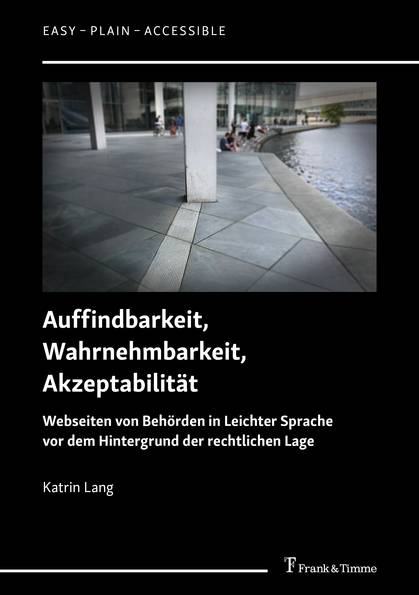
Auffindbarkeit, Wahrnehmbarkeit, Akzeptabilität
Katrin Lang
Content (German)
Viele Behörden sind inzwischen zur Verwendung von Leichter Sprache auf ihren Internetseiten verpflichtet. Das Ziel ist die Verbesserung der Teilhabe von Menschen mit Behinderung. Doch sind die gesetzlichen Vorgaben und die daraus entstandene Textpraxis aus Sicht der Barrierefreien Kommunikation dazu geeignet, dieses Ziel zu erreichen? Zur Beantwortung dieser Frage nimmt Katrin Lang die in der Forschung bislang wenig thematisierten Kategorien „Auffindbarkeit“, „Wahrnehmbarkeit“ und „Akzeptabilität“ in den Blick. Sie zeigt, warum viele Texte, die auf der Grundlage des Behindertengleichstellungsgesetzes und der Barrierefreie-Informationstechnik-Verordnung (BITV) entstanden sind, Mängel im Bereich der Akzeptabilität aufweisen und eine sogenannte „Motivationsbarriere“ enthalten. Darüber hinaus erklärt Lang, wie es gelingen kann, behördliche Webseiten auf Bundes-, Landes- und kommunaler Ebene für Menschen mit Kommunikationseinschränkungen nicht nur auffindbar, wahrnehmbar und verständlich, sondern auch akzeptabel und handlungsleitend zu gestalten.
Vol. 11 (2021)
Silvana Deilen: Optische Gliederung von Komposita in Leichter Sprache
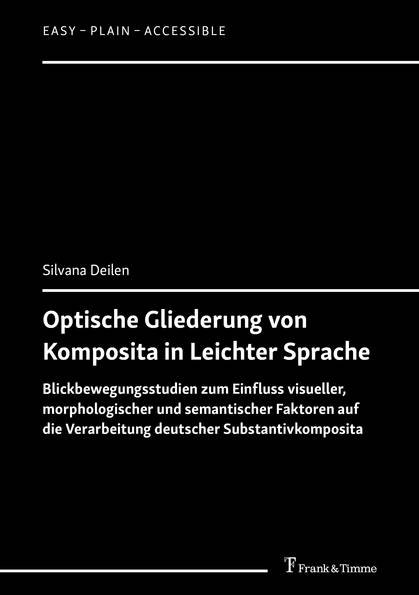
Optische Gliederung von Komposita in Leichter Sprache
Silvana Deilen
Content (German)
Ein wesentliches Merkmal der deutschen Sprache ist ihre Kompositionsfreudigkeit. Für Menschen mit Leseeinschränkungen sind komplexe Wörter jedoch problematisch. In Leichter Sprache werden sie deshalb optisch gegliedert. Doch tragen die derzeit gängigen Gliederungsmöglichkeiten wirklich zur besseren Verständlichkeit der Wörter bei? Silvana Deilen vergleicht die verschiedenen Gliederungsmöglichkeiten mittels Blickbewegungsstudien. Neben den durch Eye-Tracking gemessenen Phasen der kognitiven Verarbeitungsprozesse berücksichtigt sie dabei auch die unterschiedlichen Lesekompetenzen und kognitiven Fähigkeiten der Leser. Die so entschlüsselten Zusammenhänge veranschaulicht sie in einem neuen Modell. Dieses kann u. a. zur Erklärung des unterschiedlichen Leseverhaltens von Menschen mit stärker und schwächer ausgeprägten Lesefähigkeiten herangezogen werden. Neue Ansätze und Impulse für die Weiterentwicklung von Reduktionsvarietäten wie Leichte und Einfache Sprache runden den Band ab.
Vol. 12 (2022)
Elena Husel: Leichte Sprache in der Bundesverwaltung
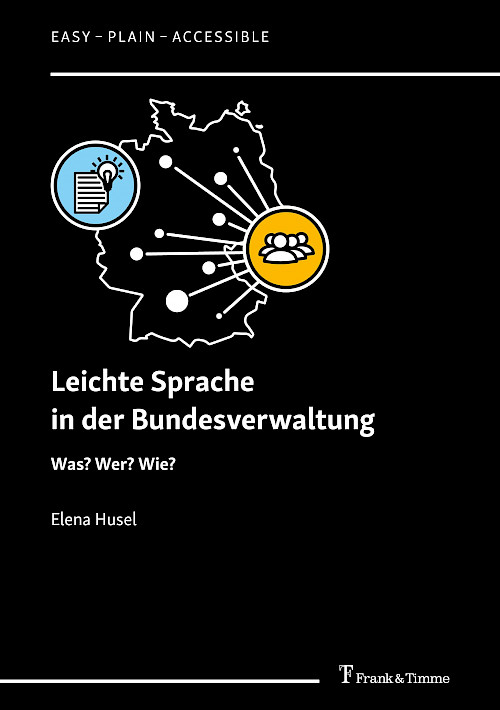
Leichte Sprache in der Bundesverwaltung
Elena Husel
Content (German)
Die Barrierefreie Kommunikation hat Einzug in die deutschen Behörden gehalten. Bundesbehörden sind seit 2020 dazu verpflichtet, Angebote in Leichter Sprache anzubieten. Das Ziel ist der Abbau von Kommunikationsbarrieren zwischen der Verwaltung und den Bürgerinnen und Bürgern, also zwischen der Profi- und Laienebene. Doch wer sind die professionellen Akteurinnen und Akteure Leichter Sprache in den Behörden? Und wie genau generieren sie Angebote in Leichter Sprache?
Elena Husel beantwortet diese Fragen erstmals für Behörden auf Bundesebene. Pointiert und vortrefflich illustriert stellt sie die Funktionen Leichter Sprache für die Zielgruppen vor. Im Fokus steht dabei der Weg von Auffindbarkeit und Wahrnehmbarkeit bis hin zu Verständlichkeit als Kernfunktion von Texten in Leichter Sprache. Die Autorin erläutert den juristischen Rahmen und die Implementierung Leichter Sprache in der Verwaltung. Ihr besonderes Augenmerk liegt auf den Akteurinnen und Akteuren, die in den Behörden mit Leichter Sprache arbeiten, sowie auf dem Prozess der Entstehung dieser barrierefreien Angebote.
Vol. 13 (2022)
Sarah Ahrens, Rebecca Schulz, Janina Kröger, Sergio Hernández Garrido, Loraine Keller & Isabel Rink (eds.): Accessibility – Health Literacy – Health Information
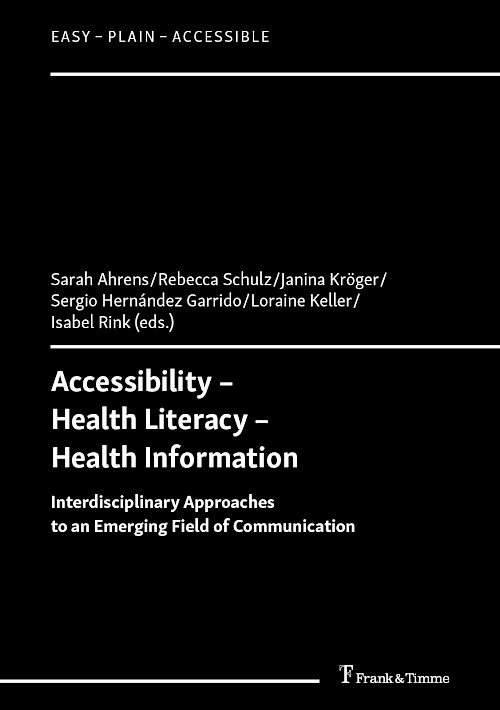
Accessibility – Health Literacy – Health Information
Sarah Ahrens, Rebecca Schulz, Janina Kröger, Sergio Hernández Garrido, Loraine Keller, Isabel Rink
Content
Recent studies show that more than half of the German population have difficulties in accessing, understanding, appraising, and applying health information, thus giving accessibility in health communication new traction. This volume links research and practice in the areas of accessible communication, health information and health literacy. The articles focus on these fields from a methodological, text and/or user perspective. The authors examine how to improve accessibility of research methods and how to adapt existing methods to answer questions about accessibility of health information. They discuss accessibility of text types and link accessibility to individual, organisational and professional health literacy. Contributions also give insight to the implementation of Easy and Plain Language in health information. All articles stem from different fields: in bringing them together, this volume fosters interdisciplinary exchange to communicate accessible health information and methods to specific vulnerable target groups.
Vol. 14 (2023)
Silvana Deilen, Silvia Hansen-Schirra, Sergio Hernández Garrido, Christiane Maaß & Anke Tardel (eds.): Emerging Fields in Easy Language and Accessible Communication Research
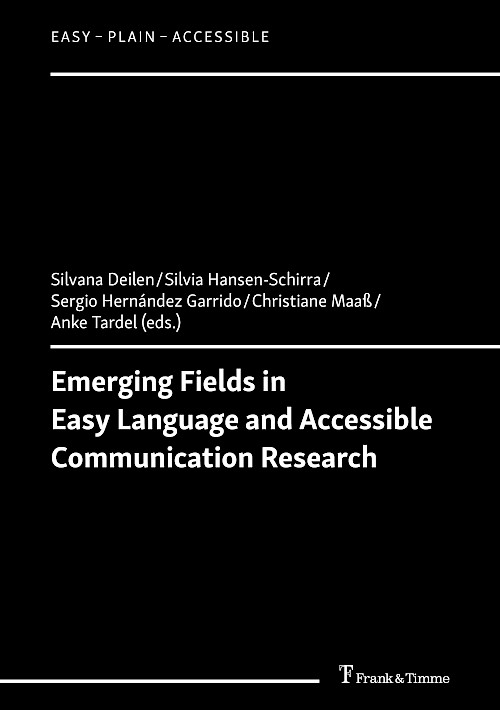
Emerging Fields in Easy Language and Accessible Communication Research
Silvana Deilen, Silvia Hansen-Schirra, Sergio Hernández Garrido, Christiane Maaß & Anke Tardel (eds.)
Content
This volume presents current research and practices in the field of Easy Language and accessible communication. The publication of this volume was inspired by two international events, namely the International Easy Language Day Conference (IELD), and the panel The Social Role of Language: Translation into Easy and Plain Languages at the IATIS conference. By bringing together findings from different corpus-driven, cognitive and automation approaches in accessible communication research and providing insights into current projects of the emerging field of accessible health communication, the volume captures the dynamic and rapidly evolving nature of the field.
